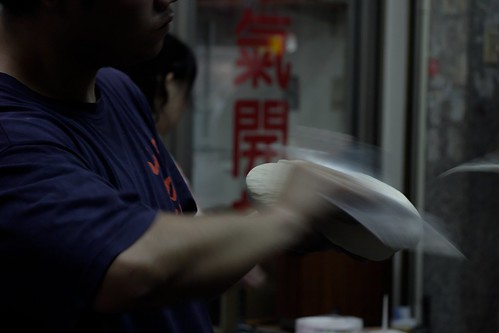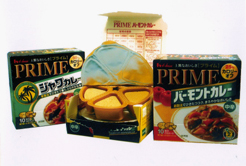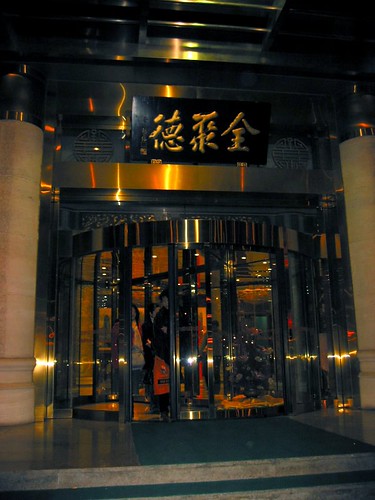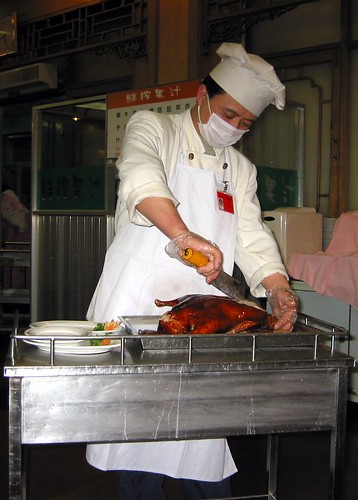
Taichung, Taiwan February 15, 2006
At this noodle shop in Taichung, they serve noodles made by slicing off slivers of dough from a bread-loaf block of dough, flicking them into a cauldron of boiling water.
A simple rhetorical question…
[8:44] Joe: if hootie and the blowfish ate fugu, would it be cannibalism?
[8:45] Adamu: if just hootie ate it then no
[8:45] Adamu: but it might be impossible to separate hootie from the blowfish
But then, this spanner got thrown into the equation:
The band’s name comes from two of [lead singer Darius] Rucker’s friends, neither of whom was ever a band member. One, with a round face and glasses, was nicknamed Hootie because of his perceived owl-like appearance. The Blowfish also got his nickname from his facial appearance, in his case chubby cheeks.
So it wouldn’t be cannibalism as long as “Hootie and the Blowfish” refers to the band, and not to the actual Blowfish. Now you know, and knowing is half the battle.
On a side note, a friend of mine just had a very bad experience with fugu prepared by his girlfriend. He didn’t die (fortunately), but it made him quite ill. So, a tip for all you Japanophiles out there: Don’t eat your girlfriend’s fugu unless she knows what she’s doing!
My translation of a Nikkeinet article.
“I even like sashimi” Taiwan’s KMT party secretary denies being “anti-Japan” to media
“Reports that the KMT walks lockstep with the mainland (China) in their anti-Japan campaign do not reflect my real feelings. I even love sashimi!” On the 10th Ma Ying Jiu (mayor of Taipei), chairman of the KMT[Chinese Nationalist Party], Taiwan’s largest opposition party, assembled Japanese reporters resident in Taipei and issued a denial of the viewpoint that he was himself a believer in anti-Japan ideology.
There are indications that the KMT has been intensifying their anti-Japan tendencies, such as stressing their own role in the Sino/Japanese war. “We criticize even the white terror (of KMT despotic rule) and (China’s) Tainanmen incident from the same basis of human rights and constutituional government. There’s no reason to make an issue out of only Japan,” Chairman Ma Ying Jiu said.
However, “I do not approve of Prime Minister Junichiro Koizumi’s Yasukuni Shrine visits,” he said, not forgetting that stab in the neck. Ma Ying Jiu is currently considered the favorite to win in Taiwan’s next presidential election.
Doesn’t the “but, I like sashimi defense” have the same ring to it as, “but I have so many black friends” or “but Jews are so funny”? I’m amazed that this is the best that Ma could come up with.
We’ve all been hearing so much about how the mad cow disease related beef embargoe is going to damage Japan/US relations so badly that we might as well be going back to the day before Little Boy fell out of the Enola Gay, but according to this article in The Mainichi, there’s actually been another large-scale food embargo going on for some time.
Japan will allow foreign potatoes into the country for the first time, accepting a U.S. proposal to brush or wash off all dirt before shipping, send them in sealed containers, and limit their use to processed potato chip snacks, an official said Wednesday.
Japan decided to accept the proposal after 17 months of deliberations, which included sending a team of experts to the United States from July to August 2005, said Masashi Kaneda of the Plant Protection Quarantine Division at the Agriculture Ministry.
Until now, Japan banned imports of foreign potatoes to keep out potato wart fungus and a potato eelworm, the ministry said.
Potato wart fungus has been eradicated in the United States since 1992, while potato eelworm has been limited to areas in New York state, the ministry said.
If potatoes had been banned until now, why is beef attracting so damn much attention?

Thanks to Comedy PC Diary:
House Foods to Transform Curry’s Seasoning with Development of No-Fat Stock Cubes
It has been almost 50 years since the birth of household curry stock in Japan. But now a new product has arrived that will likely transform the flavor of curry rice, which has become a staple of Japan’s dinner tables as “the people’s food.”
Its creator is House Foods (based in Chiyoda Ward, Tokyo). They announced on Feb. 3 that they have developed curry base that can be packed into cubes without using fat. Since it reduces the amount of fat included in the total base, it will bring out the aroma of the spices and the seasonings of the buillon that were hidden in the fat, making it possible to cook low-calorie, delicious curry.
The new curry base using this technology will be released March 6 under the name “PRIME Curry.”
Due to the progression of an aging society, in 2007 the number of single-person households will overtake the number of married-with-children families. The retirement of the “baby-boom generation” will begin, and the number of married couples eating as a couple at home are expected to rise. Even curry rice, which was considered optimal for cooking when dining with a large number of people, will be required to be healthier and have a more robust flavor corresponding to the increasing needs of people eating in small groups.
House Foods developed this new technology to meet those needs. The new curry has 25-30% fewer calories than previous curry products.
When the company applies for a patent for the new technology, it will also open a new production facility at its Kanto factory in Sano City, Tochigi Prefecture at an investment of 2 billion yen. For the time being, the new curry will only be sold in Eastern Japan (Hokkaido, Tohoku, Kanto, and Shin’etsu regions) due to production limitations, but will debut nationwide next spring.
The “Prime Vermont Curry” and “Prime Jawa Curry” will both cost 300 yen before tax. House predicts annual sales of 3 billion yen.
No, it’s not the title of the newest Godzilla spinoff, but the stars of the two recent seafood related news stories that have been making waves in Japan.
I’ll start with kujira, which is the Japanese word for whale. Japan has not just continued it’s program of so-called “scientific whaling,” in which they violate the international treaty prohibiting commercial whaling while pretending they haven’t, but is actually increased their catch. This is despite the fact that almost nobody actually likes whale meat.
According to the report, the inventory was about 1,000 to 2,500 tons around 1995. It hit a low point of 673 tons in March 1998 but began to increase to reach 4,800 tons last August.
[…]
The Fisheries Agency admits the whale meat inventory is rising and has begun studying ways to expand sales in Japan.“It is true that such a trend exists. We will study ways to expand sales channels as well as to reform sales methods,” an agency official said.
Such moves by the government to stimulate the whale meat market will probably draw more criticism from antiwhaling groups that fear more consumption in Japan.
Since 2000, the research whaling has been expanding in terms of volume and number of species. On the other hand, consumption has not increased as areas of high demand for whale meat are limited in Japan.
“Unless the consumption of whale meat increases dramatically, the stockpile of whale meat will surge,” Sakuma said.
I’m not interested in getting into the debate over whether or not commercial whaling should be allowed, but irrelevant to that argument I can say that this current policy is just absurd. While Japan has been making some progress in their battle to change the treaty banning commercial whaling, they have, in fact, signed a treaty banning commercial whaling. They are, in fact, violating that treaty while pretending not to. The fact that Japan is carrying out their whaling operations illegally only makes it easier for opponents of whaling to continue to attack them by adding the illegality of it to the moral/environmental argument, in contrast to Noraway, who carries out fully legal commercial whaling by virtue of having never signed the anti-whaling treaty.
Echizen (actually echizen kurage) are a species of massive (200kg) but benign (as in, they aren’t the stinging kind) jellyfish that have recently been multiplying like crazy in Chinese and Korean waters, and drifting towards Japan in plague-like proportions. There are so many of these gigantic blobs floating around the Sea of Japan that it has actually become impossible for fisherman to put out their nets without catching some, sometimes to the point where catching actual fish becomes almost impossible.

South Korean fishermen have been suffering similar woes, but China, where giant jellyfish are a delicacy often served dried and dressed with sesame oil, does not seem to have registered the outbreak as a major problem, Japanese officials said.
Seaside communities in Japan have tried to capitalize on the menace by developing novel jellyfish dishes from tofu to ice cream, but for some reason the recipes have failed to take off.
Participants at Thursday’s conference said they had experimented with feeding the jellyfish to farmed crabs and using them as fertilizer.
 What we have here are, basically, are two different sources of sea-borne protein, and neither one is even remotely popular or has much of a market. One form of protein is for some reason being pursued with vigor despite the fact that doing so leads to both international controversy and such a massive excess of the stuff that it ends up just rotting (or at least staying frozen) in warehouses.
What we have here are, basically, are two different sources of sea-borne protein, and neither one is even remotely popular or has much of a market. One form of protein is for some reason being pursued with vigor despite the fact that doing so leads to both international controversy and such a massive excess of the stuff that it ends up just rotting (or at least staying frozen) in warehouses.
The second form of protein is also in no particular demand as a food source, but it is so abundant that it is literally washing up on the shores of Japan and clogging the nets of fishermen.
Japan’s commercial whaling is a diplomatic and economic failure, and all the resources being spent by the government in supporting it are a complete and utter waste, serving no purpose except to satisfy a nostalgic fantasy of older people who remember eating whale meat in the school lunches in the years after the Second World War when far more desirable meats like pork or beef were difficult to come by.
 The sea is so thick with echizen jellyfish that catching some is unavoidable, and therefore figuring out how to exploit them as a resource is an economic necessity in areas where the fishing industry is disrupted. From a purely market based standpoint, an increase in the catch of unwanted whales is absurd, and the slow pace of developing echizen into a positive resource is wasteful in another way.
The sea is so thick with echizen jellyfish that catching some is unavoidable, and therefore figuring out how to exploit them as a resource is an economic necessity in areas where the fishing industry is disrupted. From a purely market based standpoint, an increase in the catch of unwanted whales is absurd, and the slow pace of developing echizen into a positive resource is wasteful in another way.
As stocks of wild fish are becoming depleted in some areas, the farming of fish is becoming steadily more popular. But to support fish grown in farms, they still have to send out trawlers to catch huge hauls of smaller fish species to use as feed, so even though they aren’t catching as many, let’s say salmon or tuna, they may still be depleting the species that those fish survive on in the wild. Perhaps the echizen, which naturally are more abundant than ever, could be become a primary source of protein for farmed seafood, and by extension, the humans who eat them.
Yes, I know that Beijing and Peking are different ways to write the same thing, but when have you ever seen “Beijing Duck” written on the menu of a Chinese restaurant?
Anyway, today’s Taipei Times mentions that the famous Quanjude duck restaurant in Beijing is planning to open a branch (or branches) in Taiwan. I ate at this restaurant during my trip to Beijing a couple of years ago, along with Saru and Younghusband, and I’ve got to say that their Peking duck was among the most delicious things I have ever eaten. I have, before and since, had Peking duck perhaps somewhere between a half dozen and ten times on other occassions and at other restaurants, but there is absolutely no comparison.
The article states that, due to avian flu concerns, the Taiwanese government will (maybe quite reasonably) not allow the import of actual ducks from China, but the unique glaze and signature multi-hour slow roasting process of the duck is what makes Quanjude so amazing.

The entrance to the restaurant in Beijing.

This is actually the statue they have in front of the building. You can see the restaurant’s name written on the duck’s hat.

A chef wheels the entire duck over to your table on a cart, and then slices the meat right in front of you. A waitress then prepares one pancake for each person, presumably so you can see how it’s meant to be done, and then leave you to your feast.
Conversation I had with MF a few weeks ago while we were taking a look at Japanese satellite TV operator SkyPerfecTV’s channel offerings:
MF: you should just quit your job and fly to japan next week
MF: screw the apartment
Adamu: dont tempt me
MF: you can get a job at nova
Adamu: haha
MF: and then go home to your sweet, sweet tv
Adamu: ok now that IS sad
MF: and a big can of kirin
MF: or asahi dry
Adamu: asahi
Adamu: id have to have a good tv
Adamu: maybe i could get those tv goggles
Continue reading My new life in Japan
Some thoughts from Christopher Hitchens in yesterday’s Wall Street Journal (print edition, which I only read when travelling by air):
Considering Thanksgiving, that most distinctive and unique of all American holidays, there need be no resentment and no recrimination. Likewise, there need be no wearisome present-giving, no order of divine service, and no obligation to the dead. This holiday is like a free gift, or even (profane though the concept may be to some readers) a free lunch—and a very big and handsome one at that…
It is the sheer modesty of the occasion that partly recommends it. Everybody knows what’s coming. Nobody acts as if caviar and venison are about to be served, rammed home by syllabub and fine Madeira. The whole point is that one forces down, at an odd hour of the afternoon, the sort of food that even the least discriminating diner in a restaurant would never order by choice.
You know, he’s right on that last part. Facing a cooler of cheesecake and pumpkin pie at Costco the other day, I picked the pumpkin pie with no deliberation. And although pumpkin pie is tasty, I would have picked the cheesecake on any other day of the year, again with no deliberation. That’s cultural brainwashing at work. Not that I’m complaining; pumpkin pie is like autumn leaves, the sort of thing a year wouldn’t be complete without.
If you’re “nihongo-ready,” or don’t mind wading through unreadable text to look at awesome photos, visit Okamoto’s Iraqi “Food” Diary. Hiroshi Okamoto is a photographer who went to Samawah, Iraq on assignment. He took pictures of food, people, more food, more people, and the occasional borderline war zone. And, like any good Japanese person, he complained about the lack of beer.
Adamu’s initial response: “That is the most hep blog ever… tagging AND Iraqi food!”